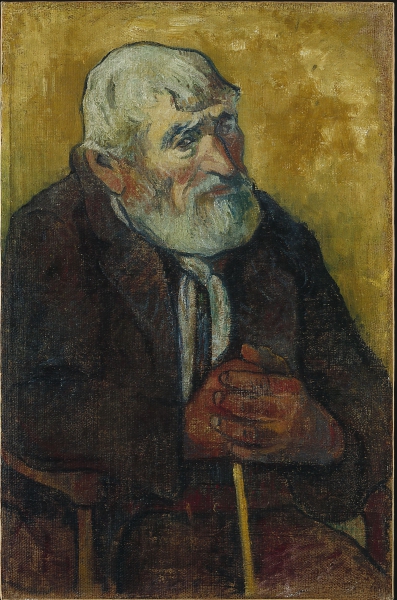art-Gauguin.com
Paul Gauguin 1848-1903
Paul Gauguin - Old Man with a Stick 1888
 Old Man with a Stick |
From Petit Palais, City of Paris Fine Art Museum:
This portrait of an old man sitting down was painted during Gauguin’s short stay in Arles. From 23 October to 26 December 1888 the painter was based in a workshop in the south of France, where he had been invited by Van Gogh. The two artists lived and worked very intensively there.
Gauguin arrived from Pont-Aven where he had just painted an exceptional picture entitled Vision of the Sermon (Edinburgh, National Gallery of Scotland). Moving definitively away from Impressionism, he developed an original style and intensified the colours that he used arbitrarily.
Vincent, who had been based in the south of France since February 1888, painted luminous sunflowers. He was also mainly concerned with painting self-portraits and portraits: “I want to paint men and women with that something of the eternal which the halo used to symbolise,” (Letter from Vincent to Theo, 3 September 1888). It was in this state of mind that in August 1888 he painted a portrait of Patience Escalier, an old oxherd from the Camargue, in front of a bright orange background, to suggest a sunset according to Vincent. The position of the old man’s hands crossed over the stick appears again, almost identically, in the picture painted by Gauguin during the final weeks of their cohabitation.
An iconographic detail confirms that the Old Man with a Stick was painted in the house in Arles: the armchair on which his left arms rests is identical to the one painted in a still life by Van Gogh in November: Gauguin’s Chair (Amsterdam, Van Gogh Museum) and can be recognised in several portraits of this period. During these winter months, the rain and freezing wind meant they had to work indoors. The two friends often painted together in the workshop on the ground floor, facing the model sitting in the armchair. The sittings would go on into the night, in the light of the gas lamps.
Another clue tells us that this work was painted in Arles : the big brown sackcloth bought in large quantities by Gauguin and used at the time by the two residents of the Yellow House. Gauguin, whose technique differed from Vincent’s generous impastos, painted using very little paint, so that the colour and irregularities of this jute canvas show through in places. Only the face, head and hands have been reworked and display thicker brush strokes. This unsigned portrait probably remained incomplete.